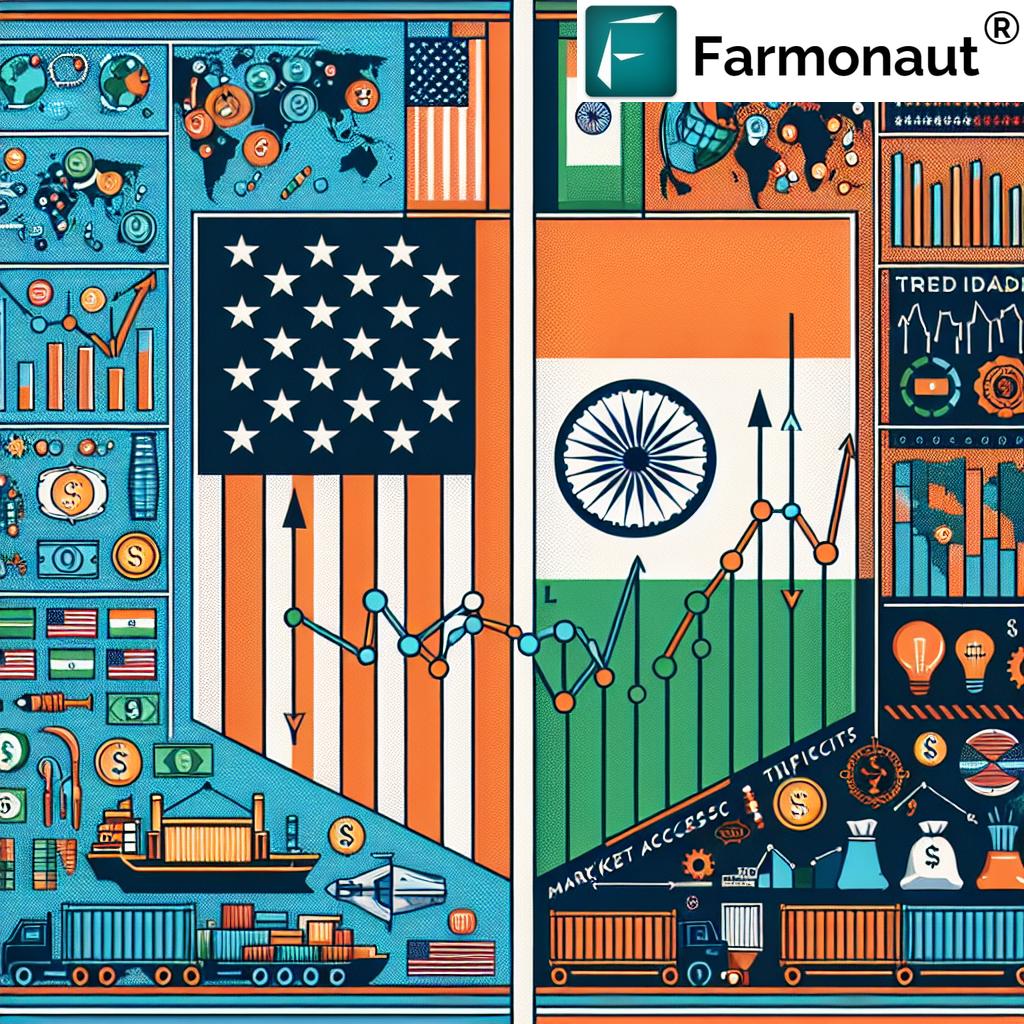US-India Trade Negotiations: Resolving Tariff Challenges for Economic Partnership
“US-India trade negotiations focus on addressing high tariffs, with American automobiles facing up to 100% import duties in India.”
In the ever-evolving landscape of international trade, the ongoing negotiations between the United States and India have taken center stage. As two of the world’s largest economies, the resolution of tariff challenges between these nations holds significant implications for global trade dynamics. In this comprehensive analysis, we delve into the intricacies of the US-India trade negotiations, exploring the complexities of tariff policies and their potential impact on the economic partnership between these two powerhouses.
The Current State of US-India Trade Relations
The United States and India have long been important trading partners, but recent years have seen increased tension due to tariff disparities and trade imbalances. As of 2025, both nations are actively engaged in negotiations to address these issues and strengthen their economic ties. The discussions primarily focus on reducing high tariffs on American goods in India, particularly in sectors such as automobiles, agriculture, and alcoholic beverages.
Recent developments have shown promising signs of progress. In a White House press briefing, U.S. President Donald Trump expressed optimism about the ongoing talks, describing Indian Prime Minister Narendra Modi as a “very smart man” and a “great friend.” This positive rhetoric suggests a willingness on both sides to find mutually beneficial solutions to the existing trade challenges.

Key Issues in the US-India Trade Negotiations
The ongoing trade talks between the United States and India revolve around several critical issues:
- High Tariffs on American Goods: India’s tariff rates on various U.S. imports have been a significant point of contention. The United States has consistently pushed for lower tariffs to improve market access for American products.
- Trade Deficit: The U.S. aims to address the trade imbalance with India, which has been a concern for American policymakers.
- Market Access: Improving access to the Indian market for U.S. companies, particularly in sectors like agriculture, automobiles, and alcoholic beverages, is a key objective for American negotiators.
- Reciprocal Tariffs: The U.S. has proposed implementing reciprocal tariffs to mirror the duties imposed by India on American exports.
Comparative Analysis of US-India Tariff Rates
To better understand the tariff disparities between the two nations, let’s examine a comparative analysis of tariff rates across key sectors:
| Sector | US Tariff Rate (%) | India Tariff Rate (%) | Potential Impact on Trade | Proposed Changes |
|---|---|---|---|---|
| Automobiles | 2.5 | 100 | Significant barrier for U.S. auto exports | Gradual reduction of Indian tariffs |
| Agriculture | 2.6 (average) | 32.8 (average) | Limited access for U.S. agricultural products | Phased lowering of Indian tariffs on key products |
| Alcoholic Beverages | 1.5 (average) | 150 | Restricted market for U.S. spirits and wines | Substantial reduction in Indian duties |
| Electronics | 1.7 (average) | 20 (average) | Challenges for U.S. tech exports | Alignment of Indian rates with global standards |
This table illustrates the significant disparities in tariff rates between the United States and India across various sectors. These differences have been a major point of contention in trade negotiations, with the U.S. pushing for more balanced tariff structures to enhance market access for American goods.
Progress in Trade Talks
Recent discussions between U.S. and Indian officials have shown signs of progress. Prime Minister Modi’s visit to Washington in February marked a crucial stage in these talks, with both sides attempting to address tariff-related concerns. The focus has been on finding common ground and developing strategies to reduce trade barriers while balancing the interests of both nations.
Key areas of progress include:
- Discussions on phased reduction of tariffs in sensitive sectors
- Exploration of alternative trade mechanisms to boost bilateral commerce
- Consideration of sector-specific agreements to address unique challenges
- Dialogue on enhancing cooperation in emerging technologies and digital trade
“The US-India trade deficit reached $23.3 billion in 2019, highlighting the need for balanced economic partnership discussions.”
Challenges in Implementing Reciprocal Tariffs
While the U.S. has proposed implementing reciprocal tariffs as a measure to balance trade relations, this approach presents several challenges:
- Complexity of Implementation: Determining how to apply reciprocal tariffs – whether at a national level, product-specific level, or through non-tariff measures – is a complex process.
- Potential for Escalation: There’s a risk that reciprocal tariffs could lead to a cycle of retaliatory measures, potentially harming both economies.
- Impact on Global Supply Chains: Disruptions to established trade flows could affect global supply chains, impacting businesses in both countries and beyond.
- Compliance with WTO Rules: Any new tariff measures must be carefully crafted to comply with World Trade Organization (WTO) regulations.

Potential Outcomes of US-India Trade Negotiations
As negotiations progress, several potential outcomes are emerging:
- Phased Tariff Reductions: A gradual lowering of tariffs in key sectors, allowing industries time to adapt to new trade conditions.
- Sector-Specific Agreements: Targeted deals in areas like agriculture or technology, addressing unique challenges in each industry.
- Enhanced Market Access: Measures to improve access for U.S. companies in the Indian market, potentially coupled with reciprocal benefits for Indian firms in the U.S.
- Investment Facilitation: Agreements to promote and protect bilateral investments, fostering deeper economic ties.
- Digital Trade Framework: Development of rules governing digital commerce and data flows between the two nations.
Impact on Various Industries
The outcomes of these negotiations will have far-reaching effects across multiple sectors:
Automotive Industry
The automotive sector stands to be significantly impacted by any changes in tariff structures. Currently, U.S. auto exports face high barriers in India, with tariffs up to 100%. A reduction in these rates could open up new opportunities for American manufacturers in the Indian market. Conversely, it may also lead to increased competition for domestic Indian automakers.
For businesses looking to optimize their operations in this changing landscape, Farmonaut’s fleet management solutions can provide valuable insights. By leveraging satellite technology and AI, these tools can help automotive companies streamline their logistics and reduce operational costs in an evolving trade environment.
Agricultural Sector
Agriculture remains a sensitive area in trade talks, with both countries having significant farming populations to consider. Lowering tariffs on agricultural products could benefit U.S. farmers seeking access to the vast Indian market. However, it also raises concerns about the impact on small-scale Indian farmers.
In this context, Farmonaut’s crop plantation and forest advisory services can be particularly beneficial. These tools use satellite data and AI to provide valuable insights on crop health and management, helping farmers in both countries adapt to changing market conditions and optimize their production.
Alcoholic Beverages
The high tariffs on imported spirits and wines in India have long been a point of contention. Reducing these tariffs could lead to increased market share for U.S. brands in India’s growing alcoholic beverage market. However, it may also intensify competition for domestic Indian producers.
Technology and Electronics
As both countries aim to strengthen their positions in the global tech industry, negotiations in this sector are crucial. Lowering barriers for technology transfers and electronic goods could foster innovation and collaboration between U.S. and Indian tech companies.
Implications for Global Trade
The outcome of US-India trade negotiations will have implications beyond bilateral relations:
- Influence on Regional Trade Dynamics: A successful agreement could set precedents for trade negotiations with other countries in the region.
- Impact on Multilateral Trade Systems: The negotiations may influence discussions at the WTO and other global trade forums.
- Shift in Global Supply Chains: Changes in tariff structures could lead to realignments in global supply chains, affecting businesses worldwide.
The Role of Technology in Facilitating Trade
As trade negotiations progress, technology plays an increasingly important role in facilitating smoother trade processes and ensuring compliance with new regulations. Solutions like Farmonaut’s satellite-based technologies can be instrumental in this regard.
For instance, Farmonaut’s blockchain-based traceability solutions can help ensure transparency and compliance in supply chains. This is particularly relevant for industries like agriculture and textiles, where product origin and journey are crucial for meeting trade standards and regulations.
Similarly, Farmonaut’s carbon footprinting tools can assist businesses in monitoring and reducing their environmental impact. As sustainability becomes an increasingly important factor in international trade, these technologies can help companies adapt to evolving environmental standards and regulations.
The Path Forward
As US-India trade negotiations continue, several key factors will shape the path forward:
- Political Will: The commitment of leadership in both countries to reach a mutually beneficial agreement is crucial.
- Stakeholder Engagement: Involving industry representatives and considering the interests of various sectors will be important for crafting a balanced deal.
- Global Economic Context: The broader global economic situation, including recovery from the pandemic and geopolitical factors, will influence negotiations.
- Technological Advancements: Emerging technologies and digital trade considerations will play an increasingly important role in shaping trade policies.
Conclusion
The ongoing US-India trade negotiations represent a critical juncture in the economic relationship between these two global powers. As discussions progress, finding a balance between reducing trade barriers and protecting domestic interests remains a key challenge. The potential outcomes of these talks could reshape not only bilateral trade but also influence global trade dynamics.
For businesses operating in this evolving landscape, staying informed and adaptable is crucial. Leveraging technologies like those offered by Farmonaut can provide valuable insights and tools to navigate changing trade conditions, optimize operations, and ensure compliance with new regulations.
As we look to the future, the resolution of tariff challenges between the U.S. and India has the potential to unlock new opportunities for economic growth and collaboration. By fostering a more balanced and open trade relationship, both nations can pave the way for a stronger, more resilient economic partnership in the years to come.
FAQ Section
- Q: What are the main issues in US-India trade negotiations?
A: The main issues include high tariffs on American goods in India, addressing the trade deficit, improving market access for U.S. companies, and the potential implementation of reciprocal tariffs. - Q: How might reciprocal tariffs impact trade between the US and India?
A: Reciprocal tariffs could lead to more balanced trade but may also risk escalating trade tensions and disrupting established supply chains. - Q: Which sectors are most affected by current tariff structures?
A: The automotive, agricultural, alcoholic beverages, and technology sectors are among the most significantly affected by current tariff disparities. - Q: How might a US-India trade deal impact global trade dynamics?
A: A successful agreement could set precedents for other trade negotiations, influence discussions at the WTO, and potentially lead to shifts in global supply chains. - Q: What role does technology play in facilitating trade between the US and India?
A: Technology plays a crucial role in areas such as supply chain traceability, carbon footprinting, and agricultural management, helping businesses adapt to new trade regulations and optimize their operations.
For more information on how technology can assist in navigating these complex trade dynamics, explore Farmonaut’s innovative solutions:
Earn With Farmonaut: Affiliate Program
Earn 20% recurring commission with Farmonaut’s affiliate program by sharing your promo code and helping farmers save 10%. Onboard 10 Elite farmers monthly to earn a minimum of $148,000 annually—start now and grow your income!
Farmonaut Subscriptions





